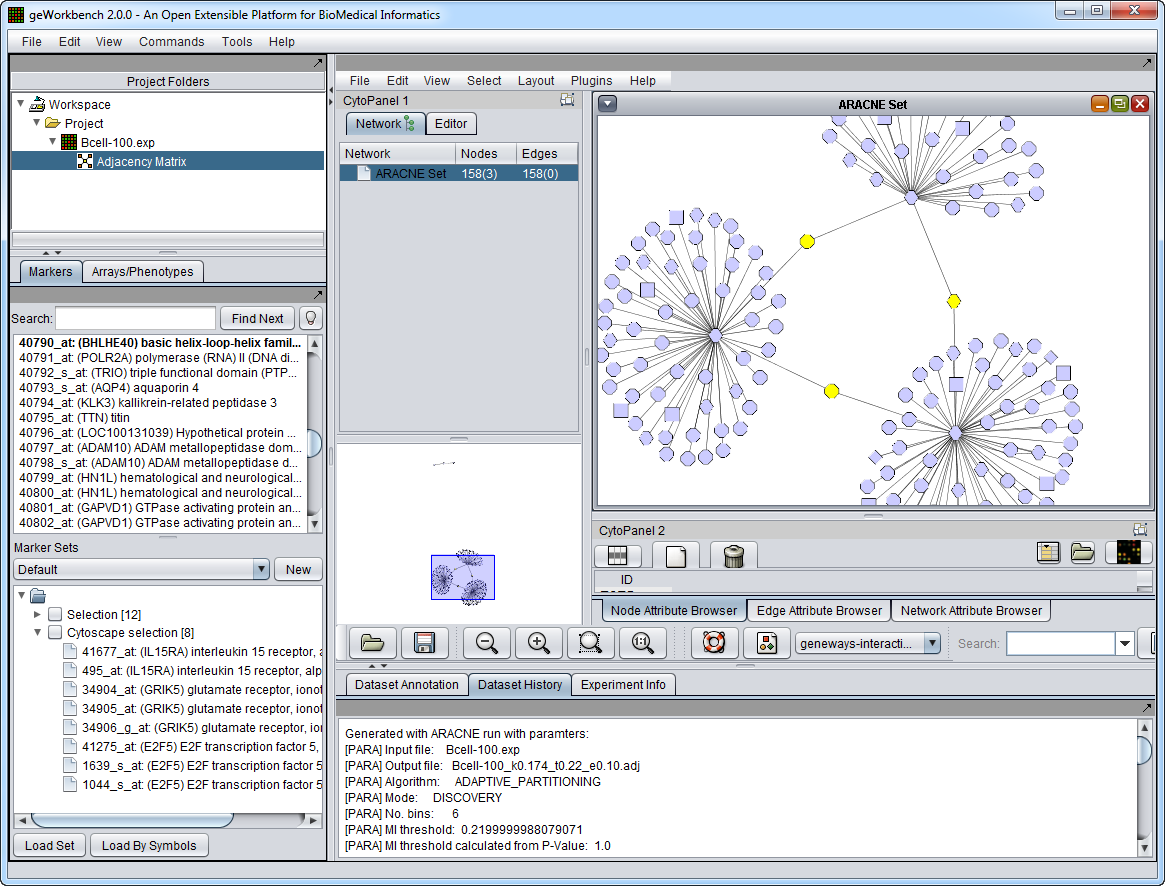Difference between revisions of "Home"
m (→Major new features) |
(→Quick Start) |
||
| Line 18: | Line 18: | ||
==Quick Start== | ==Quick Start== | ||
A [[QuickStart| Quick Start]] guide to geWorkbench is being developed. | A [[QuickStart| Quick Start]] guide to geWorkbench is being developed. | ||
| + | |||
| + | ==Graphical User Interface== | ||
[[Image:GeWB_GUI_Cytoscape.png]] | [[Image:GeWB_GUI_Cytoscape.png]] | ||
| − | |||
==Summary of changes in geWorkbench release 2.0.0== | ==Summary of changes in geWorkbench release 2.0.0== | ||
Revision as of 15:04, 14 June 2010
Contents
Overview
geWorkbench version 2.0.0 was released on June 9th, 2010. We recommend that all users upgrade to the latest version. The Release Notes and downloads can be obtained from https://gforge.nci.nih.gov/frs/?group_id=78, and installation instructions can be found on the Download and Installation page of this Wiki.
geWorkbench (genomics Workbench) is a Java-based open-source platform for integrated genomics. Using a component architecture it allows individually developed plug-ins to be configured into complex bioinformatic applications. At present there are more than 70 available plug-ins supporting the visualization and analysis of gene expression and sequence data. Example use cases include:
- loading data from local or remote data sources.
- visualizing gene expression, molecular interaction networks, protein sequence and protein structure data in a variety of ways.
- providing access to client- and server-side computational analysis tools such as t-test analysis, hierarchical clustering, self organizing maps, regulatory neworks reconstruction, BLAST searches, pattern/motif discovery, etc.
- validating computational hypothesis through the integration of gene and pathway annotation information from curated sources as well as through Gene Ontology enrichment analysis.
geWorkbench is the Bioinformatics platform of MAGNet, the National Center for the Multi-scale Analysis of Genomic and Cellular Networks (one of the 7 National Centers for Biomedial Computing funded through the NIH Roadmap). Additionally, geWorkbench is supported by caBIG®, NCI's cancer Biomedical Informatics Grid initiative.
End-user and developer support for geWorkbench is provided through the caBIG® Molecular Analysis Tools Knowledge Center, a component of the caBIG® Enterprise Support Network.
Quick Start
A Quick Start guide to geWorkbench is being developed.
Graphical User Interface
Summary of changes in geWorkbench release 2.0.0
Major new features
- Filtering - completely revamped - now works directly for all modes, allows specification of minimum % matching arrays before filtering occurs.
- File parsers added:
- MAGE-TAB data matix
- GEO Soft format - added series (GSE) and curated matrix (GDS).
- Java 6 - Moved from Java 5 to Java 6. geWorkbench now requires Java 6. Works on both 32 bit and 64 bit VMs (JREs).
- Look and Feel - Switched to new, more modern Look and Feel (Nimbus). geWorkbench appearance now consistent across all platforms.
- caBIO component updated from 4.2 to 4.3.
- Cellular Network Knowledge Base (CNKB) - Revamped interface to allow choice of interactome and data types.
- More than 250 additional "bug reports" were closed. These included improvements in the usability of numerous components, and actual bug fixes.
New Components
- Skybase - SkyBase is a database that stores the homology models built by SkyLine analysis for all NESG PSI2 protein structures. It is queried using FASTA-format protein sequence files.
- Skyline - A high-throughput comparative modeling pipeline. It creates structural homology models for protein sequences with similarity to a protein with an experimentally determined 3-D structure. The input is a PDB file. (Depends on an internal server, external use not yet enabled).
- Pudge - Interface to a protein structure prediction server which integrates tools used at different stages of the structural prediction process. Modeling starts with a FASTA-format protein sequence file.
Other major changes
- caArray - Improved memory usage on downloads from caArray.
- CNKB - Can now return markers direct from CNKB without use of Cytoscape.
- Color Mosaic - enhancements to display (bug 2147):
- toggle array names on/off
- search on array name, accession, or label
- Component Configuration Manager - now can filter display list by categories: Analysis, Viewer, Normalizer, Filter.
- Cytoscape - Corrected mapping between gene names in Cytoscape display and markers in Marker Sets panel (now uses Entrez IDs).
- Dendrogram - can now create Array subsets as well as marker subsets.
- Markers and Arrays - Hover text available in Markers and Arrays phenotypes to visualize long names if needed.
- Marker Annotation - search results can be saved to a text file, including relevant URLs and pathway BioCarta pathway names.
- File loading - Checking for "out of memory" errors during file loading.
- GUI - in switching to new Look and Feel, fixed many text highlighting problems that were previously seen on Macintosh only but now appeared on Windows also.
- File parser menu - The file parser selection menu now shows valid file extensions for each type.
- Promoter - JASPAR promoter motifs now filterable by taxon.
- Sequence alignment (BLAST) - many enhancements, including added additional databases to match those listed at NCBI improved handling of results from searches containing long query sequences.
See also the list of changes in previous releases.

